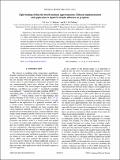Tight binding within the fourth moment approximation: Efficient implementation and application to liquid Ni droplet diffusion on graphene
Author(s)
Los, J. H.; Bichara, Christophe; Pellenq, Roland J. -M.
DownloadLos-2011-Tight binding within the fourth moment approximation.pdf (776.5Kb)
PUBLISHER_POLICY
Publisher Policy
Article is made available in accordance with the publisher's policy and may be subject to US copyright law. Please refer to the publisher's site for terms of use.
Terms of use
Metadata
Show full item recordAbstract
Application of the fourth moment approximation (FMA) to the local density of states within a tight binding description to build a reactive, interatomic interaction potential for use in large scale molecular simulations, is a logical and significant step forward to improve the second moment approximation, standing at the basis of several, widely used (semi-)empirical interatomic interaction models. In this paper we present a sufficiently detailed description of the FMA and its technical implications, containing the essential elements for an efficient implementation in a simulation code. Using a recent, existing FMA-based model for C-Ni systems, we investigated the size dependence of the diffusion of a liquid Ni cluster on a graphene sheet and find a power law dependence of the diffusion constant on the cluster size (number of cluster atoms) with an exponent very close to −2/3, equal to a previously found exponent for the relatively fast diffusion of solid clusters on a substrate with incommensurate lattice matching. The cluster diffusion exponent gives rise to a specific contribution to the cluster growth law, which is due to cluster coalescence. This is confirmed by a simulation for Ni cluster growth on graphene, which shows that cluster coalescence dominates the initial stage of growth, overruling Oswald ripening.
Date issued
2011-08Department
Massachusetts Institute of Technology. Department of Civil and Environmental EngineeringJournal
Physical Review B
Publisher
American Physical Society
Citation
Los, J., C. Bichara, and R. J. M. Pellenq. “Tight Binding Within the Fourth Moment Approximation: Efficient Implementation and Application to Liquid Ni Droplet Diffusion on Graphene.” Physical Review B 84.8 (2011): [12 pages]. ©2011 American Physical Society.
Version: Final published version
ISSN
1098-0121
1550-235X